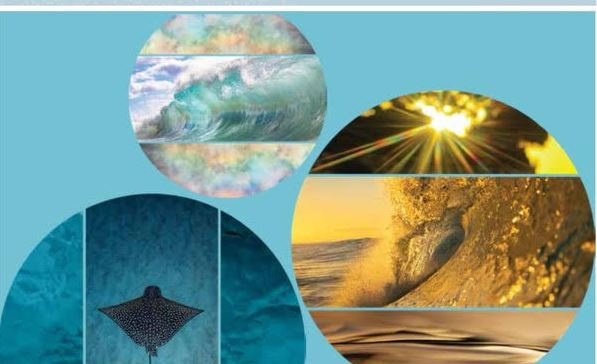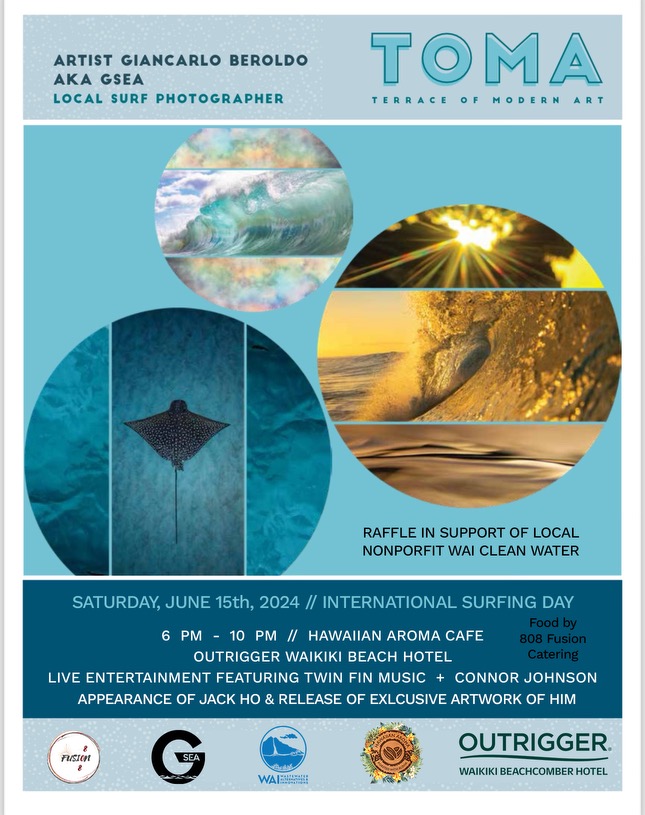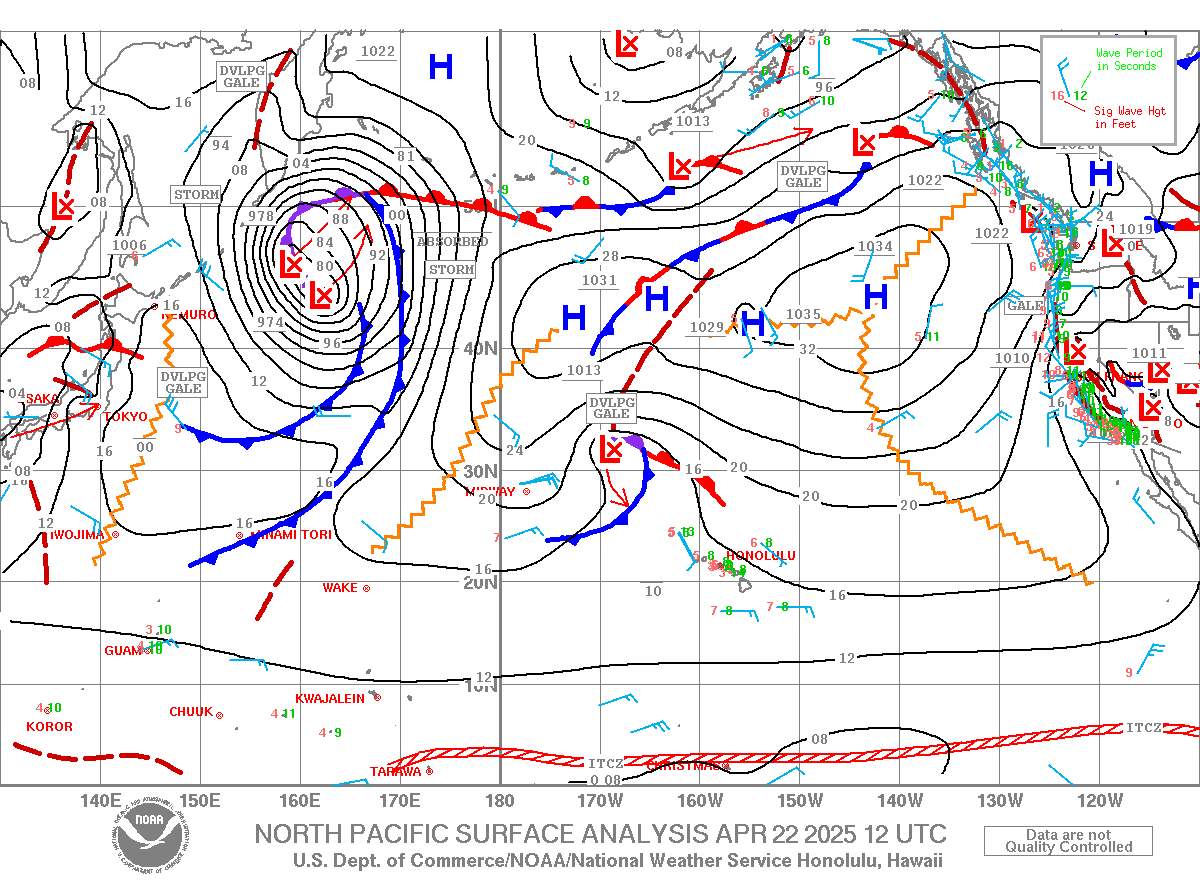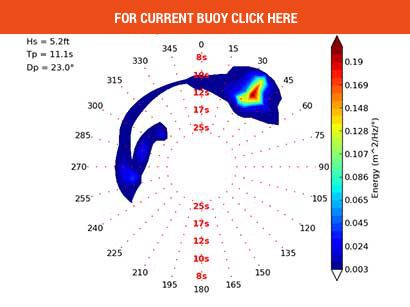
SUMMER KICK-OFF PARTY AT HAWAIIAN AROMA CAFE
TO CELEBRATE INTERNATIONAL SURFING DAY

HONOLULU – June 15th, 2024 – The nonprofit Wastewater Alternatives & Innovations (WAI) is partnering with local surf photographer Giancarlo Beroldo (AKA GSea) and the Hawaiian Aroma Cafe to host an art exhibit and fundraising party at the Outrigger Waikiki Beach Hotel on June 15th from 6-10pm. As part of the Cafe’s Terrace Of Modern Art (TOMA) series, the event will feature original surf art by GSea, live music by the bands Twin Fin and Connor Johnson and ono food by Fusion808.
The party is free and open to the public, and it will be held on International Surfing Day, which takes place each year on the third Sat. in June. The purpose of the party is to celebrate the Hawaiian sport of surfing, Hawaii’s gift to the world of watersports. A portion of proceeds will be donated to WAI to support their efforts to protect water quality and reduce sewage pollution from cesspools around the state.
As part of the art show, GSea will be launching a new series of original photographs printed on recycled metals, paper and old vinyl records. Unlike most traditional photographs, these unique pieces are circular and divided into three sections called triptychs. All of the images reflect the artist’s love of surfing and the ocean. “Surfing has helped me find my place in the community and played a huge role in who I am today,” says Giancarlo Beroldo, the artist known as GSea. “I wouldn’t have started ocean photography or my career as an artist if I had not taken up surfing, and I feel especially grateful to be able to work with WAI in helping protect and maintain the water quality in Hawaii.”
A special set of photographs will feature pro surfer Jack Ho, who grew up in Waikiki. An all-around waterman, Ho is equally talented on shortboards, longboards or hydrofoils. Ho will be at the party to celebrate International Surfing Day. “I’m so grateful to have been raised in an ocean community, centered around water sports,” Ho says. “It has shaped my career and has made me the person I am today.”
Along with his artwork, GSea will also be signing copies of his new photography book Light, Water, Life: Visions of the Pacific, which was just published in March of this year. After the event at Hawaiian Aroma Cafe, part of the exhibit will then be displayed at Ars Cafe on Montserrat Ave. for a month, starting on June.
For more information about GSea’s artwork, go to GSea.Online.
About WAI:
WAI is an environmental non-profit dedicated to protecting water quality in Hawai’i by reducing sewage pollution and introducing more innovative, eco-friendly and affordable sanitation solutions. For more info, go to www.WaiCleanWater.org.
HISTORY OF INTERNATIONAL SURFING DAY
International Surfing Day was initiated in 2005 by “Surfing Magazine” and the Surfrider Foundation. The holiday was created to promote the sport of surfing, as well as educate people about the negative impact of their activities on the ocean and the environment. On International Surfing Day, various activities are held, such as surfing contests, barbecues, and other fun surf-centered activities. Several groups also organize beach clean-ups and other restorative activities as a way of contributing positively to the environment.
Body-surfing has likely existed since humans began swimming in the ocean. However, surfing with the assistance of apparatus has been traced to the ancient cultures of Peru, where people surfed on reed watercraft for recreational and fishing purposes. Modern surfing with the use of surfboards, however, originates from pre-colonial Hawaii, which was introduced to the innovation by the Polynesians. Written evidence of surfing in Polynesia can be found in the journal of Joseph Banks during his stay in Tahiti in 1769. In Hawaii, surfing became more than a hobby or sport, moving into the realm of religion, culture, and art. It was referred to as ‘he’e nalu,’ meaning “wave sliding.” Before surfing, the people would pray to the gods for protection and strength. The making of surfboards also required the assistance of a priest.
According to historians Kim Stoner and Geoff Dunn, surfing made its debut in the United States in July 1885 when four teenage Hawaiian princes arrived in California. David Kawananakoa, Edward Keli’iahonu, Jonah Kūhiō Kalaniana’ole, and Elle Mancini all surfed at the San Lorenzo River on redwood boards. In 1961, the United States Surfing Association was established, arguably becoming the first professional surfing contest organization in the world. Today, surfing is not just a sport but a lifestyle, which can now be found on all populated continents.





















